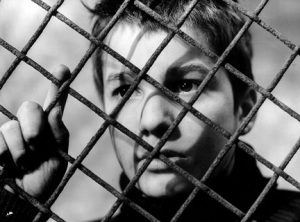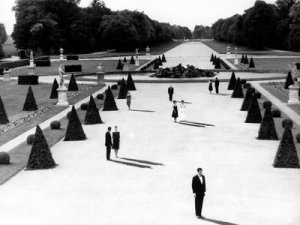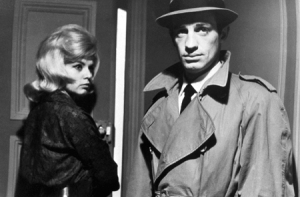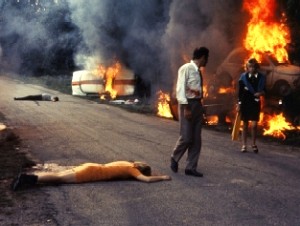
This year marks the 50th anniversary of the start of La Nouvelle Vague, the French New Wave which transformed and dominated European cinema in the late 1950′s and 1960′s. Although the majority of French films from this decade are blanketed with the term Nouvelle Vague, the movement encompassed many different styles and approaches to cinema from a wide variety of directors. The New Wave filmmakers were all united by their desire to alter the horizons of cinema, rejecting the formalist traditions of the classical style, although they never formally recognised themselves as being part of one conscious group, more a body of young filmmakers sharing the same iconoclastic mindset. However, despite their wish to rewrite the cinematic rulebook, many of the directors had a great appreciation for classical cinema. In fact, the movement’s origins began with the magazine Cahiers du Cinema, which saw critics and future pioneering directors Francois Truffaut, Eric Rohmer, Jean-Luc Godard, Claude Chabrol and Jacques Rivette create anew the doctrine of film theory and criticism. Under the guidance of Cahiers founder Andre Bazin, the critics were instrumental in re-evaluating the importance of classical films both in France (from Renoir, Vigo and Cocteau) and in Hollywood. The Cahiers writers felt that the artistic achievements of certain Hollywood directors were undervalued, as they had always been associated with the restrictive American studio production line. Through these writings, the manifesto for ‘Les Politiques des Auteurs’ emerged, where the critics argued that the stylistic approaches and use of mise-en-scene gave some films greater merit beyond their generic narratives. These theories greatly enhanced the critical value of Hollywood director’s oeuvres, notably Nicholas Ray, John Ford, Orson Welles, Howard Hawks and Alfred Hitchcock. Francois Truffaut even conducted lengthy interviews with Hitchcock for a book published in 1967. The Cahiers critics were really the first to celebrate the American films of the 1940′s and 1950′s that are now regarded as classics.
 To
represent the varied approaches within the Nouvelle Vague, I’ve chosen
to briefly discuss four of my favourite films from the movement, all of
which represent very different interpretations of the wave’s intentions
from four key directors. The 400 Blows (1959) is
generally considered the first film of the wave. Directed by Francois
Truffaut, it tells the story of troubled teenager Antoine Doinel, as he
struggles at home and at school, finally being sent to a detention camp
after being misunderstood by his parents and the authorities as an
incorrigible trouble maker. The film gives a bleak, realistic
presentation of events, an influence from Robert Bresson and also the
Italian neo-realist style, but combines it with playful cinematic
techniques including jump cuts and freeze frames. In the final sequence,
the camera tracks Antoine running along the beach
To
represent the varied approaches within the Nouvelle Vague, I’ve chosen
to briefly discuss four of my favourite films from the movement, all of
which represent very different interpretations of the wave’s intentions
from four key directors. The 400 Blows (1959) is
generally considered the first film of the wave. Directed by Francois
Truffaut, it tells the story of troubled teenager Antoine Doinel, as he
struggles at home and at school, finally being sent to a detention camp
after being misunderstood by his parents and the authorities as an
incorrigible trouble maker. The film gives a bleak, realistic
presentation of events, an influence from Robert Bresson and also the
Italian neo-realist style, but combines it with playful cinematic
techniques including jump cuts and freeze frames. In the final sequence,
the camera tracks Antoine running along the beach towards the ocean for the first time in his life, followed by a zoom in and a sudden freeze frame, as Antione apparently stares at the audience. It’s undoubtedly one of the most memorable and powerful moments in cinema history. The 400 Blows clearly expresses the New Wave’s unwritten manifesto of rejecting traditionally structured linear narrative, instead presenting an episodic account more interested in the experiences of the character, as well as the film’s stunning black and white photography. This film would become the first episode in an unprecedented twenty-year series of four films and one short, showing the young Antoine (always played by Jean-Pierre Leaud) become an adult, fall in love and start a family in Antoine And Colette (1962), Stolen Kisses (1968), Bed And Board (1970) and Love On The Run (1979). A similar romantic story with dark realistic overtones was Truffaut’s 1962 masterpiece Jules et Jim, which gave Truffaut even greater scope for innovative techniques. Similarly, Godard’s Bande A Part (1964) explored a dangerous love triangle with playful exuberance, whilst Jacques Remy’s The Umbrellas Of Cherbourg (1964) presented a romantic liaison as a musical in glorious technicolour, giving Catherine Deneuve her breakthrough role.

Alain Resnais’ Last Year At Marienbad (1961) is a film rich with symbolism and vague meaning. Having previously been revered for his acclaimed dramatic-documentary Hiroshima Mon Amour (1959), Resnais collaborated with writer Alain Robbe-Grillet (later another New Wave director) on his first fictional narrative feature, although the shifting perspectives of Marienbad would make it far removed from other narrative films in the movement. Whilst Truffaut, Godard and Chabrol represented the Cahiers directors, Resnais represented the Rive Gauche or ‘Left Bank’ filmmakers, alongside Chris Marker, Anges Varda and Robbe-Grillet. These distinctively bohemian directors took the approaches of the New Wave to more experimental levels. Resnais imbues Marienbad with a subtle sense of strangeness - in the vivid scenes of the chateau’s garden (pictured), the people walking cast long dark shadows, whilst the numerous pointed trees cast no shadow at all. The film abandons plot and narrative in favour of images, events and the sense of characters caught in a dream-like state of repeated memory. Unsurprisingly, the film divided critics, who either saw it as a beautiful masterpiece or a bewildering exercise in self-indulgence. In truth, Last Year At Marienbad is a hypnotic combination of both these things – it is at once beautiful and bewildering, but I don’t really believe it’s worth analysis beyond mentioning it’s powerfully arresting visuals. The film is an open-book for interpretive meanings and debates, which can be enjoyed as much as it can be alienating. However, it is the major film of the New Wave to fully embrace the movement’s art house leanings, an approach taken to even bolder experimentation in Jacques Rivette’s Celine And Julie Go Boating (1974).

Le Doulos (1962), directed by Jean-Pierre Melville, is a stylish gangster movie featuring many plot twists involving theft, murder and deception. Given the Nouvelle Vague touch, this crime thriller takes on an almost surreal aesthetic, artistically exaggerating the chiaroscuro technique associated with film noir. The hyper-reality of the world created by Melville has characters wearing strikingly overstated trench coats, shot in extreme contrasting shadows. Jean-Pierre Melville became a major figure of the New Wave, although he had been directing feature films since 1949, making him a continually strong presence in French cinema who, along with Robert Bresson, bridged the gap between the classical era and the Nouvelle Vague. Influenced by American crime movies, Melville’s noir-style thrillers were hugely influential to other New Wave directors – his 1956 film Bob La Flambeur being the first of it’s kind in France. Truffaut’s second feature, Shoot The Piano Player (1960) owed it an obvious debt, as did Godard’s pulp sci-fi classic Alphaville (1965). These classy thrillers suited the fashionable groove of the sixties and Melville became the most important exponent of the policier genre – gangster films taking their lead from American film noirs but offering a uniquely French perspective. This particular sub-genre reached it’s zenith with Melville’s own The Godson (1967) and The Red Circle (1970). Hip and referential, much of the flashy style of these noir movies had been previously explored in Godard’s seminal Nouvelle Vague masterpiece Breathless (1960), the second film from the Wave. A significant stylistic strand throughout the wave, one of the movement’s final great crime thrillers was Charles Chabrol’s The Butcher in 1970. The French noir really is the ultra-cool division of the Nouvelle Vague.
 Weekend (1967),
Jean-Luc Godard’s darkest film is a strikingly ambitious black satire
on French bourgeois society and moves from the bickering of a
middle-class couple and some aggressive road rage through to revolution,
violent murder and cannibalism. It’s surrealistic approach and fierce
attacks on the complacent middle classes make it comparable to the work
of Luis Bunuel, who was also making films in France during this period
(the similarly daring Belle de Jour was released the same year). Viscous and shocking in it’s approach, Weekend
takes the Nouvelle Vague’s reactionary course to the ultimate extreme,
incorporating moments of Brechtian disillusion and scenes of pure
fantasy (Lewis Carroll and Emily Bronte wandering in the woods springs
to mind!). Admittedly the film is a pretty hard watch and frustratingly
incomprehensible in parts (although not nearly as baffling as Godard’s
rockumentary-come-political manifesto Sympathy For The Devil in 1968), but that’s really the point – there’s something fantastically daring and exhaustively rewarding about Weekend.
For its famous and breathtaking ten-minute tracking shot of an
ever-worsening traffic jam alone, the film is a landmark in black
comedy. Allowing itself to be completely free of any strictures, the
film remains one of the most relentlessly wild and inventive additions
to the French New Wave. Weekend ends with two captions
- ‘End Of Film’ and ‘End Of Cinema’ – not only pointing to the total
collapse of civilisation within the film’s narrative but perhaps
acknowledging that Godard had taken the New Wave as far as it could
possible go.
Weekend (1967),
Jean-Luc Godard’s darkest film is a strikingly ambitious black satire
on French bourgeois society and moves from the bickering of a
middle-class couple and some aggressive road rage through to revolution,
violent murder and cannibalism. It’s surrealistic approach and fierce
attacks on the complacent middle classes make it comparable to the work
of Luis Bunuel, who was also making films in France during this period
(the similarly daring Belle de Jour was released the same year). Viscous and shocking in it’s approach, Weekend
takes the Nouvelle Vague’s reactionary course to the ultimate extreme,
incorporating moments of Brechtian disillusion and scenes of pure
fantasy (Lewis Carroll and Emily Bronte wandering in the woods springs
to mind!). Admittedly the film is a pretty hard watch and frustratingly
incomprehensible in parts (although not nearly as baffling as Godard’s
rockumentary-come-political manifesto Sympathy For The Devil in 1968), but that’s really the point – there’s something fantastically daring and exhaustively rewarding about Weekend.
For its famous and breathtaking ten-minute tracking shot of an
ever-worsening traffic jam alone, the film is a landmark in black
comedy. Allowing itself to be completely free of any strictures, the
film remains one of the most relentlessly wild and inventive additions
to the French New Wave. Weekend ends with two captions
- ‘End Of Film’ and ‘End Of Cinema’ – not only pointing to the total
collapse of civilisation within the film’s narrative but perhaps
acknowledging that Godard had taken the New Wave as far as it could
possible go.The 1960′s was a decade of many shifts and surprises in culture and accordingly many new waves in cinema – in Italy, Britain, Japan, Czechoslovakia – but the most revolutionary and influential was surely the French New Wave, which gave the world many of the greatest films ever made. Bernando Bertolucci’s The Dreamers (2003) paid explicit tribute to the films of Godard and Truffaut, and the influence of the Nouvelle Vague can still be felt today in the films of Luc Besson, Jean-Pierre Jeunet and Michel Gondry.
The BFI French New Wave Season begins in April, showcasing a number of films from the movement, including The 400 Blows and Breathless, in London and around the country.
Recommended reading: A History Of The French New Wave Cinema by Richard John Neupert; Everything Is Cinema: The Working Life Of Jean-Luc Godard by Richard Brody; Francois Truffaut: The Complete Films by Robert Ingram.
No comments:
Post a Comment